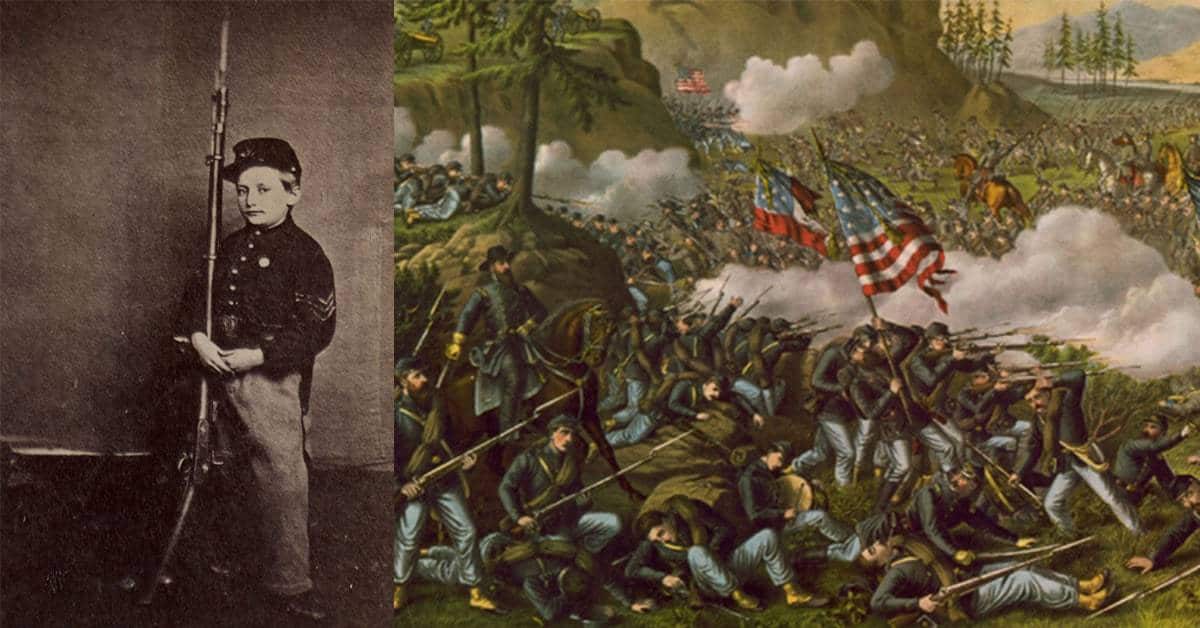The Battle of Chickamauga, fought from 18-20 September 1863, resulted in a Confederate victory, over 34,000 casualties and almost 4,000 deaths. In the midst of battle, a Confederate colonel spotted a young boy in Union uniform brandishing a rifle. He apparently ordered the boy to surrender and reportedly said: “I think the best thing a mite of a chap like you can do is drop that gun.” Instead, the drummer boy of the 22nd Michigan Infantry, John Clem, shot the colonel and scurried back towards friendly lines. It was the day that a legend was born.
A Pre-Teen Warrior
John Joseph Clem (spelled ‘Klem’ on his enlistment documentation) was born in Newark, Ohio on August 13, 1851. After his mother died in 1861 when she was hit by a train, 9-year John ran away to enlist in the Union Army as a drummer boy. He approached Captain Leonidas McDougal of the 3rd Ohio Union Regiment in the belief that his help was required. McDougal reportedly said: “I’m not enlisting infants, son.” In the Civil War, it wasn’t uncommon for boys as young as 14 to fight on the battlefield. In some cases, a boy might enlist with his father or grandfather and the army would accept him.

Little Johnny refused to quit and tried to join the 22nd Michigan Infantry. While it also refused him, he followed the unit until 1862 and served as a mascot and drummer. The army officers were so impressed by his determination that they finally allowed him to enlist officially in 1863. They even chipped in to pay his $13 monthly salary until he was a member of the group. While in the Army, he changed his name to John Lincoln Clem because he admired President Lincoln and because he thought ‘Clem’ sounded more American than ‘Klem.’
The Myth of Shiloh
There is a popular tale attributed to the life of Clem which is almost certainly a myth. It suggests that he was a drummer boy for the 22nd Michigan at the Battle of Shiloh on April 6-7, 1862. According to the legend, Clem was struck by shrapnel which went through his drum; it knocked him unconscious. His comrades found him lying on the field, and they rescued him before it was too late. They later gave him the nickname ‘Johnny Shiloh.’
In reality, the weight of evidence suggests that Clem was never at the Battle of Shiloh. First of all, the 22nd Michigan was not in active service until August 1862 which is, of course, several months after the battle. The entire Johnny Shiloh story probably comes from a song written by William S. Hays after the Battle of Chickamauga. Clem had become a national hero at that stage.
It is a little odd that the New York Times published an article in 1915 that tried to add weight to the myth. According to the publication, Clem “got into the very hottest of the fight.” Indeed, there is a suggestion that the tale about Clem running away from home aged nine and trying to join the Ohio Infantry is also a myth. However, he always stuck to his claim that he fought at Shiloh. Members of the 3rd Ohio may have fought in the battle, and in theory, Clem could have joined them. Whatever happened in Clem’s early years, sources tend to agree that his legendary actions at Chickamauga occurred.

